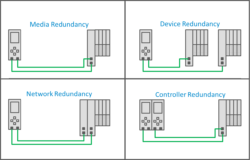Generally, in an automation network, there are many components that can potentially fail. Depending on the end user’s requirement, PROFINET allows them to build a reliable network according to their specific goals. Specifically, there are four PROFINET redundant components: Media Redundancy, Controller Redundancy, Device Redundancy, and Network Redundancy.
 Device Redundancy
Device Redundancy
A network with device redundancy has a singular controller connected to multiple devices. The controller establishes a connection to both devices simultaneously and sends the same output data to both devices. However, it marks the data sent to the secondary device as “invalid”. When a failover is triggered in the controller, it marks the secondary output data as “valid,” then the secondary device can take over seamlessly and without delay. Device Redundancy can work with any PROFINET device. Controllers usually support device redundancy with some special functions or application programming interfaces (APIs).
Controller Redundancy
A network with control redundancy has more than one controller connected to a device simultaneously. In presence of two controllers, the first one establishes a primary connection, the second controller establishes a special, “backup” connection. The backup connection doesn’t contain any valid output data. If the primary controller fails, the device waits for the backup controller to request a transition to primary status. The new primary controller coordinates the transition across the entire PROFINET network. Controller Redundancy requires special coordination from both the PROFINET devices and controllers.
Media Redundancy
Media redundancy is a function that helps ensures network availability. A common failure in a distributed IO system is a damaged Ethernet cable. Consequently, PROFINET implemented the Media Redundancy Protocol (MRP) to handle media failures without requiring any external application. MRP enables the connection of IO devices based on ring topologies. If the transmission link in the ring is interrupted at one point, the redundancy manager immediately activates the alternative communication path.
Network Redundancy
Network redundancy allows a network to continue running after a subnet failure by swapping communication to a second subnet. In a redundant network, an IO device uses two interface modules to communicate over two separate PROFINET networks. Each network module has an independent Application Relation (AR) with the PROFINET controller (2 subnets).
Read the full white paper HERE:
-Nelly Ayllon
